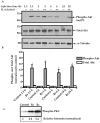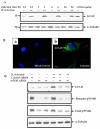Activation of Mechanistic Target of Rapamycin (mTOR) in Human Endothelial Cells Infected with Pathogenic Spotted Fever Group Rickettsiae
- PMID: 33003310
- PMCID: PMC7582468
- DOI: 10.3390/ijms21197179
Activation of Mechanistic Target of Rapamycin (mTOR) in Human Endothelial Cells Infected with Pathogenic Spotted Fever Group Rickettsiae
Abstract
Attributed to the tropism for host microvascular endothelium lining the blood vessels, vascular inflammation and dysfunction represent salient features of rickettsial pathogenesis, yet the details of fundamentally important pathogen interactions with host endothelial cells (ECs) as the primary targets of infection remain poorly appreciated. Mechanistic target of rapamycin (mTOR), a serine/threonine protein kinase of the phosphatidylinositol kinase-related kinase family, assembles into two functionally distinct complexes, namely mTORC1 (Raptor) and mTORC2 (Rictor), implicated in the determination of innate immune responses to intracellular pathogens via transcriptional regulation. In the present study, we investigated activation status of mTOR and its potential contributions to host EC responses during Rickettsia rickettsii and R. conorii infection. Protein lysates from infected ECs were analyzed for threonine 421/serine 424 phosphorylation of p70 S6 kinase (p70 S6K) and that of serine 2448 on mTOR itself as established markers of mTORC1 activation. For mTORC2, we assessed phosphorylation of protein kinase B (PKB or Akt) and protein kinase C (PKC), respectively, on serine 473 and serine 657. The results suggest increased phosphorylation of p70 S6K and mTOR during Rickettsia infection of ECs as early as 3 h and persisting for up to 24 h post-infection. The steady-state levels of phospho-Akt and phospho-PKC were also increased. Infection with pathogenic rickettsiae also resulted in the formation of microtubule-associated protein 1A/1B-light chain 3 (LC3-II) puncta and increased lipidation of LC3-II, a response significantly inhibited by introduction of siRNA targeting mTORC1 into ECs. These findings thus yield first evidence for the activation of both mTORC1 and mTORC2 during EC infection in vitro with Rickettsia species and suggest that early induction of autophagy in response to intracellular infection might be regulated by this important pathway known to function as a central integrator of cellular immunity and inflammation.
Keywords: Akt (protein kinase B); Rickettsia; endothelial cells; mTOR; protein kinase C.
Conflict of interest statement
The authors declare no conflict of interest.
Figures




Similar articles
-
Upregulation of mTORC2 activation by the selective agonist of EPAC, 8-CPT-2Me-cAMP, in prostate cancer cells: assembly of a multiprotein signaling complex.J Cell Biochem. 2012 May;113(5):1488-500. doi: 10.1002/jcb.24018. J Cell Biochem. 2012. Retraction in: J Cell Biochem. 2025 Jul;126(7):e70048. doi: 10.1002/jcb.70048. PMID: 22173835 Retracted.
-
Endothelial Mechanistic Target of Rapamycin Activation with Different Strains of R. rickettsii: Possible Role in Rickettsial Pathogenesis.Microorganisms. 2024 Jan 30;12(2):296. doi: 10.3390/microorganisms12020296. Microorganisms. 2024. PMID: 38399700 Free PMC article.
-
mTORC1 and mTORC2 Co-Protect against Cadmium-Induced Renal Tubular Epithelial Cell Apoptosis and Acute Kidney Injury by Regulating Protein Kinase B.J Agric Food Chem. 2024 Sep 11;72(36):19667-19679. doi: 10.1021/acs.jafc.4c05702. Epub 2024 Sep 1. J Agric Food Chem. 2024. PMID: 39219293 Free PMC article.
-
Survival strategies of cancer cells: the role of macropinocytosis in nutrient acquisition, metabolic reprogramming, and therapeutic targeting.Autophagy. 2025 Apr;21(4):693-718. doi: 10.1080/15548627.2025.2452149. Epub 2025 Jan 26. Autophagy. 2025. PMID: 39817564 Free PMC article. Review.
-
Melatonin effect on breast and ovarian cancers by targeting the PI3K/Akt/mTOR pathway.IUBMB Life. 2024 Dec;76(12):1035-1049. doi: 10.1002/iub.2900. Epub 2024 Aug 30. IUBMB Life. 2024. PMID: 39212097 Review.
Cited by
-
Oxidative Stress Contributes to Inflammatory and Cellular Damage in Systemic Lupus Erythematosus: Cellular Markers and Molecular Mechanism.J Inflamm Res. 2023 Feb 4;16:453-465. doi: 10.2147/JIR.S399284. eCollection 2023. J Inflamm Res. 2023. PMID: 36761905 Free PMC article. Review.
-
The host mTOR pathway and parasitic diseases pathogenesis.Parasitol Res. 2021 Apr;120(4):1151-1166. doi: 10.1007/s00436-021-07070-6. Epub 2021 Feb 3. Parasitol Res. 2021. PMID: 33534053 Free PMC article. Review.
-
Rickettsia disrupts and reduces endothelial tight junction protein zonula occludens-1 in association with inflammasome activation.Infect Immun. 2025 Jan 31;93(1):e0046824. doi: 10.1128/iai.00468-24. Epub 2024 Dec 16. Infect Immun. 2025. PMID: 39679710 Free PMC article.
-
Host-Pathogen Interaction 3.0.Int J Mol Sci. 2022 Oct 24;23(21):12811. doi: 10.3390/ijms232112811. Int J Mol Sci. 2022. PMID: 36361600 Free PMC article.
-
Apoptosis and Autophagy: Current Understanding in Tick-Pathogen Interactions.Front Cell Infect Microbiol. 2022 Jan 27;12:784430. doi: 10.3389/fcimb.2022.784430. eCollection 2022. Front Cell Infect Microbiol. 2022. PMID: 35155277 Free PMC article. Review.
References
-
- Sahni A., Narra H.P., Walker D.H., Sahni S.K. Endothelial activation and injury: The mechanisms of rickettsial vasculitis. In: Gavins F., Stokes K.Y., editors. Vascular Responses to Pathogens. Elsevier Press; Atlanta, GA, USA: 2016. pp. 111–122.
MeSH terms
Substances
Grants and funding
LinkOut - more resources
Full Text Sources
Molecular Biology Databases
Miscellaneous

